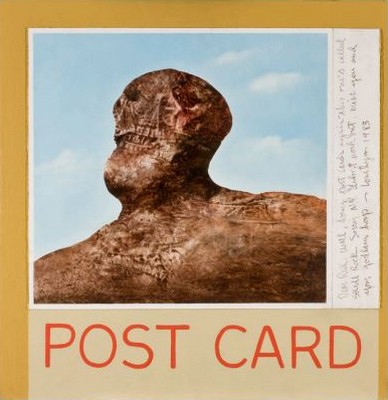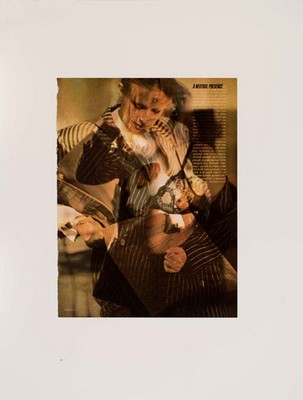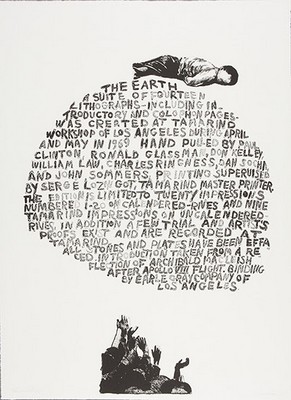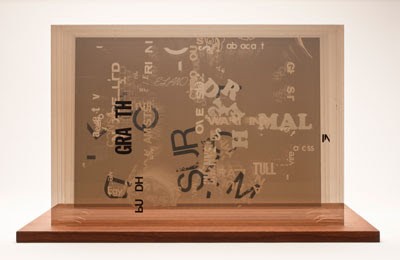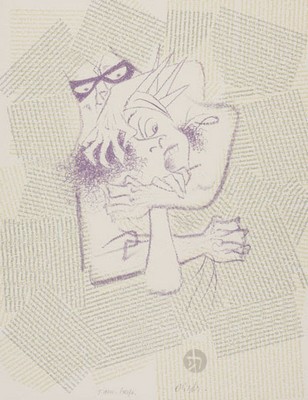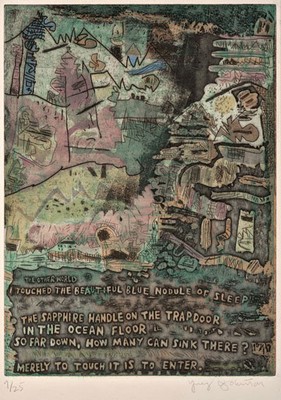Word as Image
Norton Simon Museum, Pasadena
Through February 5, 2024
The Traveler, 1915
Oil on canvas
56 x 41-1/2 in. (142.2 x 105.4 cm)
Norton Simon Art Foundation
Skull Rock, 1983
Oil on wood panel
20-3/8 x 20 in. (51.8 x 50.8 cm)
Norton Simon Museum, Gift of Kati Breckenridge, Ph.D
The Norton Simon Museum presents Word as Image, an exhibition showcasing 20th-century artists who experimented with letters, words and symbols as visual motifs. Culled from the Museum’s collection, the objects on view offer humorous and thought-provoking encounters between pictorial and linguistic modes of expression. Artists whose work is in the exhibition include Pablo Picasso, Liubov Popova, John Cage, Andy Warhol, Llyn Foulkes, Robert Heinecken, Rafael Canogar, William Gropper, Ynez Johnston and others.
At the beginning of the 20th century, words appeared as elements in avant-garde compositions, where they were used to break down distinctions between art and daily life. In Pablo Picasso’s Still Life with Bottle of Marc (1911), splintered lines and shapes reinvent the genre of trompe l’oeil still-life. Only the legible letters “E,” “vie” and “Marc” prompt the viewer to perceive the central object, a bottle of brandy, and recognize the composition as a café scene. In Liubov Popova’s Cubo-Futurist painting The Traveler (1915), snippets of Russian words like журналы (zhurnaly), meaning journals, and II кл, meaning second class, evoke a train’s physical environment. Partial bits of text parallel the fragmented appearance of Cubist and Futurist abstraction while capturing the dynamism of early 20th-century modernity.
Recto/Verso, 1/5, 1988
Silver dye bleach photogram
Image: 10-1/4 x 6-7/8 in. (26 x 17.5 cm); Sheet: 20 x 16 in.
(50.8 x 40.6 cm)
Norton Simon Museum, Gift of Darryl Curran
© The Robert Heinecken Trust, Chicago
As the century progressed, Pop and Conceptual artists responded critically to their social and cultural climates by inventing visual forms, sometimes co-opting contemporary cityscapes full of billboards and graffiti-covered walls. Claes Oldenburg and Ed Ruscha evoked Los Angeles through prints of monumental architectural letters, as both considered the city’s signage part of its essential identity. Similarly, Andy Warhol’s iconic Campbell’s Soup series (the Museum’s edition is dated 1968) appropriates the visual language of mass production and typographic design to blur the distinction between fine art and advertisement. Language also serves as an inside joke for many works in the exhibition, like Robert Heinecken’s photogram Recto/Verso, 1/5 (1988), which offers a critique of fashion magazines and beauty standards. Here a single legible headline, “A Neutral Presence,” ironically accompanies a distorted image of reversed text and superimposed women’s bodies, thereby interrupting the passive consumption of mass media.
The Earth 14, 1969
Lithograph
30 x 22 in. (76.2 x 55.9 cm)
Norton Simon Museum, Anonymous Gift
© Rafael Canogar
Not Wanting to Say Anything About Marcel, 1969
Silkscreens (8) on plexiglass set in a wooden base,
edition 39 of 125
14-3/8 x 20-1/8 x 10-5/8 in. (36.5 x 51.1 x 27.0 cm)
Norton Simon Museum, Gift of Mrs. Judith Thomas, 1970
© John Cage Trust
The exhibition features artworks that engage linguistic and art historical themes simultaneously. In Arthur Secunda’s kaleidoscopic lithograph Cathedral Voices (1969), inspired by Claude Monet’s paintings of Rouen cathedral, intentionally illegible letters conjure the acoustic and optical experiences that one may have inside a religious building. John Cage, in his own nod to art of the recent past—Not Wanting to Say Anything About Marcel (1969), an homage to the great conceptual artist Marcel Duchamp—collaborated with printers, researchers and a graphic designer. The resulting sheets of Plexiglas are printed with fragmented letters that appear to float and fall in a kind of three-dimensional typographic symphony. Designed so that it could be reassembled to create new visual compositions, it likewise uses words and letters as a means of interrogating the creative process.
Untitled (Unfinished Symphony I), 1967
Lithograph
18 x 14 in. (45.72 x 35.56 cm)
Norton Simon Museum, Anonymous Gift
© Estate of William Gropper
Travels of the Sage Narada: The Other World, 1958
Color etching with poem by John Berry
19 x 15-3/4 in. (48.3 x 40.0 cm)
Norton Simon Museum, Gift of Mr. Robert A. Rowan
© Ynez Johnston Berry
Spanning the comical to the political to the conceptual, Word as Image calls our attention to how we are constantly “reading the image” in and out of museum spaces. Many of the artworks express ambivalence about the meaning and legibility of the text contained within, emphasizing instead the formal appearance of letters or numbers. As such, artists challenge us to consider language and image anew, by positioning words as an essential part of visual culture.
Word as Image is organized by Alex Kaczenski, the Museum’s graduate intern for the 2022-23 academic year. It is on view in the Museum’s Focus Gallery on the main level.
NORTON SIMON MUSEUM
411 West Colorado Boulevard
Pasadena, California 91105
WORD AS IMAGE @ NORTON SIMON MUSEUM / AUGUST 11, 2023 – FEBRUARY 5, 2024


